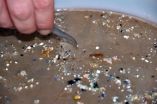(Press-News.org) As scientists learn more about earthquakes that rupture at fault zones near the planet's surface—and the mechanisms that trigger them—an even more intriguing earthquake mystery lies deeper in the planet.
Scientists at Scripps Institution of Oceanography at UC San Diego have discovered the first evidence that deep earthquakes, those breaking at more than 400 kilometers (250 miles) below Earth's surface, can rupture much faster than ordinary earthquakes. The finding gives seismologists new clues about the forces behind deep earthquakes as well as fast-breaking earthquakes that strike near the surface.
Seismologists have documented a handful of these events, in which an earthquake's rupture travels faster than the shear waves of seismic energy that it radiates. These "supershear" earthquakes have rupture speeds of four kilometers per second (an astonishing 9,000 miles per hour) or more.
In a National Science Foundation-funded study reported in the June 11, 2014, issue of the journal Science, Scripps geophysicists Zhongwen Zhan and Peter Shearer of Scripps, along with their colleagues at Caltech, discovered the first deep supershear earthquake while examining the aftershocks of a magnitude 8.3 earthquake on May 24, 2013, in the Sea of Okhotsk off the Russian mainland.
Details of a magnitude 6.7 aftershock of the event captured Zhan's attention. Analyzing data from the IRIS (Incorporated Research Institutions for Seismology) consortium, which coordinates a global network of seismological instruments, Zhan noted that most seismometers around the world yielded similar records, all suggesting an anomalously short duration for a magnitude 6.7 earthquake.
Data from one seismometer, however, stationed closest to the event in Russia's Kamchatka Peninsula, told a different story with intriguing details.
After closely analyzing the data, Zhan not only found that the aftershock ruptured extremely deeply at 640 kilometers (400 miles) below the earth's surface, but its rupture velocity was extraordinary—about eight kilometers per second (five miles per second), nearly 50 percent faster than the shear wave velocity at that depth.
"For a 6.7 earthquake you would expect a duration of seven to eight seconds, but this one lasted just two seconds," said Shearer, a geophysics professor in the Cecil H. and Ida M. Green Institute of Geophysics and Planetary Physics (IGPP) at Scripps. "This is the first definitive example of supershear rupture for a deep earthquake since previously supershear ruptures have been documented only for shallow earthquakes."
"This finding will help us understand why deep earthquakes happen," said Zhan. "One quarter of earthquakes occur at large depths, and some of these can be pretty big, but we still don't understand why they happen. So this earthquake provides a new observation for deep earthquakes and high-rupture speeds."
Zhan also believes the new information will be useful in examining ultra-fast earthquakes and their potential for impacting fault zones near the earth's surface. Although not of supershear caliber, California's destructive 1994 Northridge earthquake had a comparable size and geometry to that of the 6.7 Sea of Okhotsk aftershock.
"If a shallow earthquake such as Northridge goes supershear, it could cause even more shaking and possibly more damage," said Zhan.
INFORMATION:
Coauthors of the paper include Donald Helmberger and Hiroo Kanamori of Caltech.
Note: Project IDA, based at Scripps-IGPP, operates nearly a third of IRIS's Global Seismographic Network.
Scripps scientists discover evidence of super-fast deep earthquake
Rare high-speed rupture off Russia provides clues about similar phenomena on shallow fault zones near Earth's surface
2014-07-10
ELSE PRESS RELEASES FROM THIS DATE:
Leading scientists express rising concern about 'microplastics' in the ocean
2014-07-10
Microplastics – microscopic particles of plastic debris – are of increasing concern because of their widespread presence in the oceans and the potential physical and toxicological risks they pose to organisms.
This is the view of two of the world's most eminent authorities on the subject, Professor Kara Lavender Law, of Sea Education Association (Woods Hole, MA), and Professor Richard Thompson of Plymouth University (UK).
In an article published today in the journal Science, the two scientists have called for urgent action to "turn off the tap" and divert plastic waste ...
Control strategy for Dengue, malaria increases risk of West Nile virus
2014-07-10
Mosquitoes infected with the bacteria Wolbachia are more likely to become infected with West Nile virus and more likely to transmit the virus to humans, according to a team of researchers.
"Previous research has shown that Wolbachia -- a genus of bacteria that live inside mosquitoes -- render mosquitoes resistant to pathogen infection, thereby preventing the mosquitoes from infecting humans with the pathogens," said Jason Rasgon, associate professor of entomology, Penn State. "As a result, researchers are currently releasing Wolbachia-infected mosquitoes into the wild ...
New study shows drinking alcohol provides no heart health benefit
2014-07-10
PHILADELPHIA – Reducing the amount of alcoholic beverages consumed, even for light-to-moderate drinkers, may improve cardiovascular health, including a reduced risk of coronary heart disease, lower body mass index (BMI) and blood pressure, according to a new multi-center study published in The BMJ and co-led by the Perelman School of Medicine at the University of Pennsylvania. The latest findings call into question previous studies which suggest that consuming light-to-moderate amounts of alcohol (0.6-0.8 fluid ounces/day) may have a protective effect on cardiovascular ...
Study looks at how Twitter can be used to address specific health issues
2014-07-10
Childhood obesity is one of the top public health concerns in the United States, with 32 percent of youths aged 2-19 classified as obese as of 2012. As health problems such as childhood obesity grow, individuals and organizations have taken to Twitter to discuss the problem.
A new study, led by Jenine K. Harris, PhD, assistant professor at the Brown School at Washington University in St. Louis, examined the use of the hashtag #childhoodobesity in tweets to track Twitter conversations about the issue of overweight kids.
The study published this month in the American ...
Sophisticated radiation detector designed for broad public use
2014-07-10
CORVALLIS, Ore. – Nuclear engineers at Oregon State University have developed a small, portable and inexpensive radiation detection device that should help people all over the world better understand the radiation around them, its type and intensity, and whether or not it poses a health risk.
The device was developed in part due to public demand following the nuclear incident in Fukushima, Japan, in 2011, when many regional residents were unsure what level of radiation they were being exposed to and whether their homes, food, environment and drinking water were safe.
Devices ...
'Mississippi Baby' now has detectable HIV, researchers find
2014-07-10
The child known as the "Mississippi baby"—an infant seemingly cured of HIV that was reported as a case study of a prolonged remission of HIV infection in The New England Journal of Medicine last fall—now has detectable levels of HIV after more than two years of not taking antiretroviral therapy without evidence of virus, according to the pediatric HIV specialist and researchers involved in the case.
"Certainly, this is a disappointing turn of events for this young child, the medical staff involved in the child's care, and the HIV/AIDS research community," said NIAID ...
Your next Angry Birds opponent could be a robot
2014-07-10
With the help of a smart tablet and Angry Birds, children can now do something typically reserved for engineers and computer scientists: program a robot to learn new skills. The Georgia Institute of Technology project is designed to serve as a rehabilitation tool and to help kids with disabilities.
The researchers have paired a small humanoid robot with an Android tablet. Kids teach it how to play Angry Birds, dragging their finger on the tablet to whiz the bird across the screen. In the meantime, the robot watches what happens and records "snapshots" in its memory. ...
It's Your Game ... Keep It Real reduces dating violence among minority youth
2014-07-10
HOUSTON – (July 10, 2014) – New research from The University of Texas Health Science Center at Houston (UTHealth) shows that It's Your Game…Keep it Real (IYG), a health education program designed to delay sexual behavior and promote healthy dating relationships, can significantly reduce dating violence behaviors among minority youth.
According to the Centers for Disease Control and Prevention, 10 percent of high school youth are victims of physical dating violence and other studies suggest that more than 20 percent are victims of emotional dating violence. Previous studies ...
NOAA, partners predict significant harmful algal bloom in western Lake Erie this summer
2014-07-10
NOAA and its research partners predict that western Lake Erie will have a significant bloom of cyanobacteria, a toxic blue-green algae, during the 2014 bloom season in late summer. However, the predicted bloom is expected to be smaller than last year's intense bloom, and considerably less than the record-setting 2011 bloom.
Bloom impacts will vary across the lake's western basin and are classified by an estimate of both its concentration and how far it spreads.
Harmful algal blooms (HABs) were common in western Lake Erie between the 1960s and 1980s. After a lapse of ...
CNIO scientists develop technology to redirect proteins towards specific areas of the genome
2014-07-10
The Spanish National Cancer Research Centre (CNIO) Macromolecular Crystallography Group has managed to reprogramme the binding of a protein called BuD to DNA in order to redirect it towards specific DNA regions. Guillermo Montoya, the researcher who led the study, says the discovery: "will allow us to modify and edit the instructions contained in the genome to treat genetic diseases or to develop genetically-modified organisms." The study is published in the journal Acta Crystallographica, Section D: Biological Crystallography.
The possibility of making à la carte modifications ...
LAST 30 PRESS RELEASES:
Anthropologists offer new evidence of bipedalism in long-debated fossil discovery
Safer receipt paper from wood
Dosage-sensitive genes suggest no whole-genome duplications in ancestral angiosperm
First ancient human herpesvirus genomes document their deep history with humans
Why Some Bacteria Survive Antibiotics and How to Stop Them - New study reveals that bacteria can survive antibiotic treatment through two fundamentally different “shutdown modes”
UCLA study links scar healing to dangerous placenta condition
CHANGE-seq-BE finds off-target changes in the genome from base editors
The Journal of Nuclear Medicine Ahead-of-Print Tip Sheet: January 2, 2026
Delayed or absent first dose of measles, mumps, and rubella vaccination
Trends in US preterm birth rates by household income and race and ethnicity
Study identifies potential biomarker linked to progression and brain inflammation in multiple sclerosis
Many mothers in Norway do not show up for postnatal check-ups
Researchers want to find out why quick clay is so unstable
Superradiant spins show teamwork at the quantum scale
Cleveland Clinic Research links tumor bacteria to immunotherapy resistance in head and neck cancer
First Editorial of 2026: Resisting AI slop
Joint ground- and space-based observations reveal Saturn-mass rogue planet
Inheritable genetic variant offers protection against blood cancer risk and progression
Pigs settled Pacific islands alongside early human voyagers
A Coral reef’s daily pulse reshapes microbes in surrounding waters
EAST Tokamak experiments exceed plasma density limit, offering new approach to fusion ignition
Groundbreaking discovery reveals Africa’s oldest cremation pyre and complex ritual practices
First breathing ‘lung-on-chip’ developed using genetically identical cells
How people moved pigs across the Pacific
Interaction of climate change and human activity and its impact on plant diversity in Qinghai-Tibet plateau
From addressing uncertainty to national strategy: an interpretation of Professor Lim Siong Guan’s views
Clinical trials on AI language model use in digestive healthcare
Scientists improve robotic visual–inertial trajectory localization accuracy using cross-modal interaction and selection techniques
Correlation between cancer cachexia and immune-related adverse events in HCC
Human adipose tissue: a new source for functional organoids
[Press-News.org] Scripps scientists discover evidence of super-fast deep earthquakeRare high-speed rupture off Russia provides clues about similar phenomena on shallow fault zones near Earth's surface





